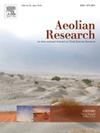Influences of soil moisture and vegetation cover on dust emission using satellite observations
IF 3.4
3区 地球科学
Q2 GEOGRAPHY, PHYSICAL
引用次数: 0
Abstract
This study presents an observational analysis of dust emission co-factors to high winds using remote sensing data across the North Africa and Western Asia dust belt. Co-factors are parameterized in climate and weather models. Observational evidence of their role and functional dependencies advance our capability to model and predict the important role of dust in radiative processes, far-field ecological nutrient transfers, and human health impacts. We use multiple years of high-temporal resolution (hourly) dust plume data, which enables analyses of emission sources, and plume extents. It also allows us to co-locate environmental factors such as wind speed, soil moisture, and vegetation and synchronize them with the time and location of major dust emission events. We focus on the combined effect of these factors in determining the frequency and intensity of dust storms, as well as identifying wind speed thresholds for dust emission at source areas. Key findings reveal wind speed thresholds twice as high as those reported in previous studies. We focus on two case studies to demonstrate the prominence of the co-factors. The case study of the Syrian Desert during the summer of 2022 illustrates the impact of dry soil, strong winds, and declining vegetation cover on the formation of severe dust storms. Additionally, the case study of the Bodélé Depression demonstrates the influence of reduced wind speed on emission frequency. The findings offer insights into how environmental conditions influence dust emission dynamics, establishing the basis for the development of more accurate dust emission models.
基于卫星观测的土壤湿度和植被覆盖对沙尘排放的影响
本文利用北非和西亚沙尘带的遥感数据,对大风的沙尘排放辅助因子进行了观测分析。辅助因子在气候和天气模式中被参数化。它们的作用和功能依赖的观测证据提高了我们模拟和预测尘埃在辐射过程、远场生态营养转移和人类健康影响中的重要作用的能力。我们使用多年的高时间分辨率(每小时)尘羽数据,这使得分析排放源和尘羽范围成为可能。它还允许我们共同定位环境因素,如风速、土壤湿度和植被,并将它们与主要粉尘排放事件的时间和地点同步。我们重点研究这些因素的综合作用,以确定沙尘暴的频率和强度,以及确定风源地区的粉尘排放风速阈值。主要研究结果显示,风速阈值是以前研究报告的两倍。我们将重点放在两个案例研究上,以证明辅助因素的重要性。对2022年夏季叙利亚沙漠的案例研究说明了土壤干燥、强风和植被覆盖减少对严重沙尘暴形成的影响。此外,以bodsamuise洼地为例分析了风速降低对发射频率的影响。这些发现为了解环境条件如何影响粉尘排放动力学提供了见解,为开发更准确的粉尘排放模型奠定了基础。
本文章由计算机程序翻译,如有差异,请以英文原文为准。
求助全文
约1分钟内获得全文
求助全文
来源期刊

Aeolian Research
GEOGRAPHY, PHYSICAL-
CiteScore
7.10
自引率
6.10%
发文量
43
审稿时长
>12 weeks
期刊介绍:
The scope of Aeolian Research includes the following topics:
• Fundamental Aeolian processes, including sand and dust entrainment, transport and deposition of sediment
• Modeling and field studies of Aeolian processes
• Instrumentation/measurement in the field and lab
• Practical applications including environmental impacts and erosion control
• Aeolian landforms, geomorphology and paleoenvironments
• Dust-atmosphere/cloud interactions.
 求助内容:
求助内容: 应助结果提醒方式:
应助结果提醒方式:


